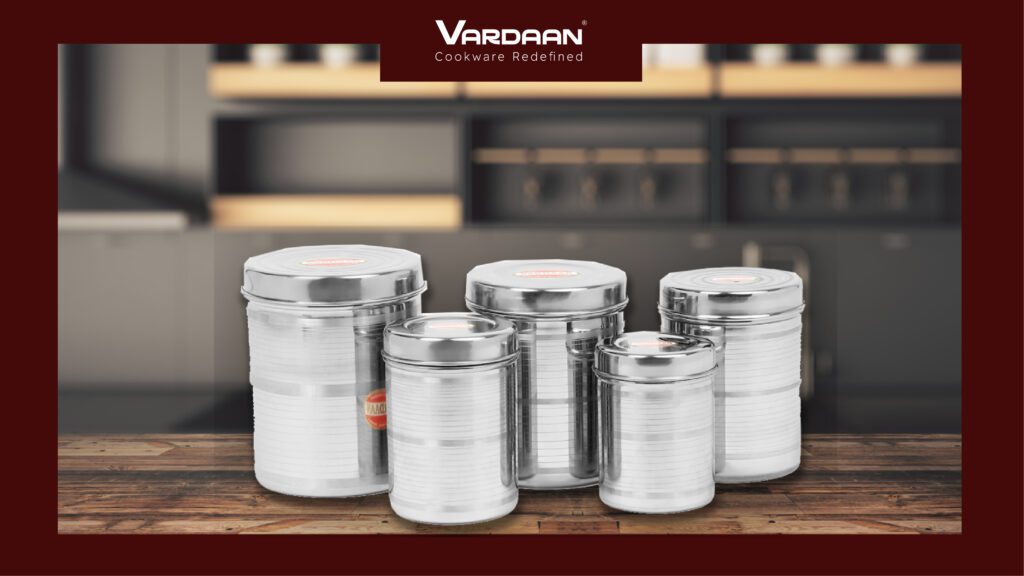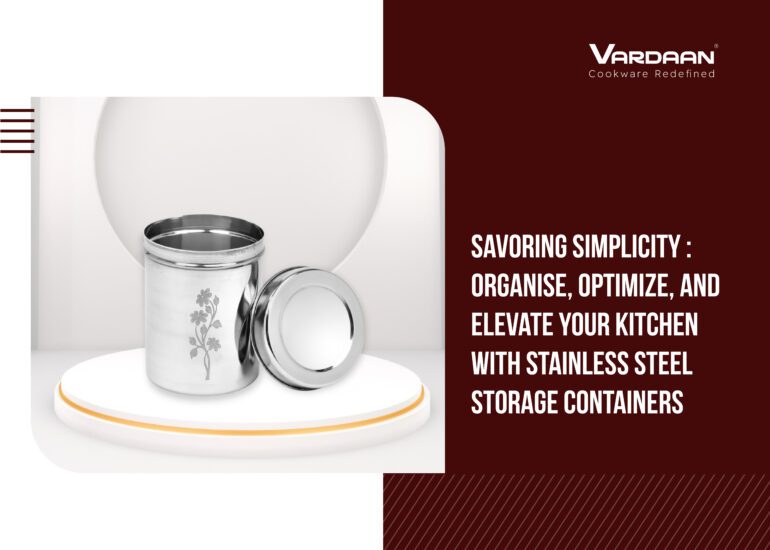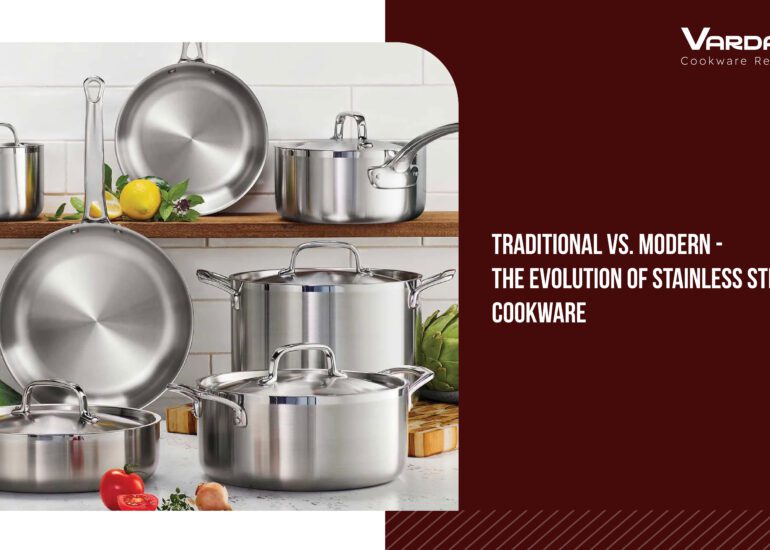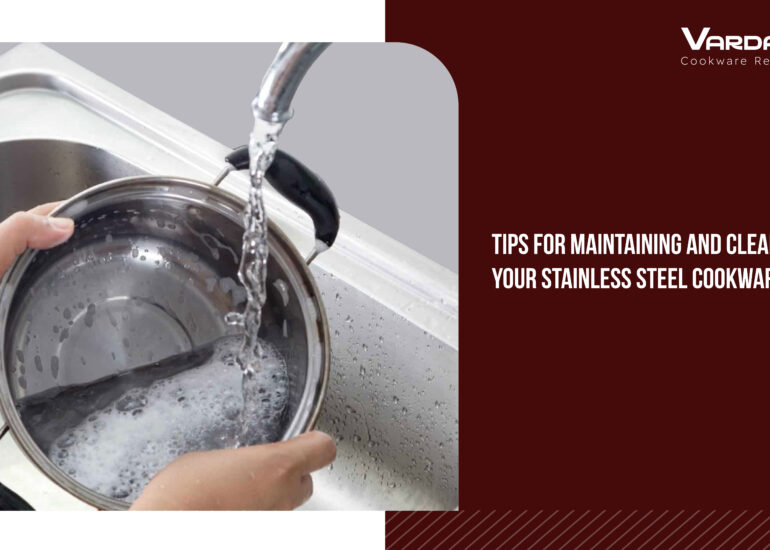Storage containers in a kitchen play a crucial role in organizing and preserving food items. These versatile vessels come in various shapes, sizes, and materials, offering convenience and efficiency. From airtight containers for keeping cereals and dry goods fresh to stackable bins for storing fruits and vegetables, they maximize space and reduce clutter. With tight lids, they prevent spoilage and extend the shelf life of perishables. Whether it’s the pantry, refrigerator, or countertop, these storage containers streamline meal preparation, promote hygiene, and simplify the overall kitchen experience. They are essential tools for maintaining a well-organized and functional culinary space.
STAINLESS STEEL CONTAINERS

Stainless steel containers have become increasingly popular in modern kitchens due to their numerous benefits. These durable and versatile containers are crafted from high-quality stainless steel, making them resistant to rust, corrosion, and staining. Their sturdy construction ensures longevity, even with regular use and frequent washing.
One of the key advantages of stainless steel containers is their non-reactive nature. Unlike plastic or glass containers, stainless steel does not leach harmful chemicals into food, making it a safe option for storing all types of ingredients. It preserves the taste, freshness, and nutritional value of the contents without any unwanted odors or flavors.
Furthermore, stainless steel containers are highly versatile. They can be used to store both hot and cold foods, as they have excellent heat retention and insulation properties. From soups and stews to salads and sandwiches, these containers are ideal for transporting meals on the go or storing leftovers in the refrigerator.
In addition to their practicality, stainless steel containers are aesthetically pleasing. The sleek and shiny appearance adds a touch of elegance to any kitchen. They are also easy to clean, as they are typically dishwasher-safe and resistant to stains and odors.
From a sustainability standpoint, stainless steel containers are an eco-friendly choice. They are reusable and eliminate the need for disposable plastic or paper containers, reducing waste and environmental impact.
Overall, stainless steel containers are a reliable and versatile storage solution for any kitchen. Their durability, safety, versatility, and aesthetic appeal make them a popular choice among home cooks and food enthusiasts alike.
TUPPERWARE CONTAINERS
Tupperware containers have revolutionized food storage with their innovative design and functionality. These iconic plastic containers, created by Earl Tupper in the 1940s, have become synonymous with convenience and organization in the kitchen.
Tupperware containers are known for their airtight seals, which lock in freshness and prevent leaks. The secure closures make them ideal for storing liquids, sauces, and even transporting meals without the worry of spills. This feature also helps to preserve the flavors and textures of food, ensuring that meals stay delicious for longer.
Another key advantage of Tupperware containers is their stackability. The containers are designed to nest within each other, saving valuable storage space in cabinets or drawers. The ability to neatly stack these containers not only keeps the kitchen organized but also allows for easy access and visibility of stored items.
Durability is a hallmark of Tupperware containers. Made from high-quality plastic, they are resistant to chipping, cracking, and breaking. This makes them long-lasting and suitable for everyday use, even in busy kitchens.
Furthermore, Tupperware containers are available in various shapes and sizes, catering to different storage needs. From small containers for dips and dressings to larger ones for storing leftovers or meal prepping, there is a Tupperware container for every purpose.
The versatility of Tupperware containers extends beyond the kitchen. They can be used for organizing craft supplies, storing office supplies, or even keeping small items in the garage. Their multi-purpose nature makes them a valuable asset in any home.
In addition to their functionality, Tupperware containers are also easy to clean. Most are dishwasher safe, saving time and effort in the kitchen cleanup routine.
With their innovative features and long-standing reputation, Tupperware containers continue to be a staple in kitchens worldwide, providing practicality, organization, and durability to users.
Which one to use – the most important decision for a homemaker
The debate between Tupperware and stainless steel containers has sparked discussions among kitchen enthusiasts. Each type of container has its own merits, and the choice ultimately depends on individual preferences and needs.
Tupperware containers, made of durable plastic, offer several advantages. They are lightweight, making them easy to carry and transport. Their airtight seals ensure food freshness and minimize the risk of leaks, making them suitable for packed lunches and on-the-go meals. Tupperware containers are also available in a wide range of sizes and shapes, offering versatility for various storage needs. Furthermore, their stackability saves space in cabinets and drawers.
On the other hand, stainless steel containers have gained popularity for their durability and non-reactive nature. They are resistant to rust, corrosion, and staining, making them long-lasting and safe for storing different types of ingredients. Stainless steel containers have excellent heat retention properties, allowing them to keep food hot or cold for longer durations. They are also eco-friendly, as they eliminate the need for disposable containers and reduce waste.
When it comes to aesthetics, Tupperware containers offer a wide array of colors and designs, adding a vibrant touch to the kitchen. Stainless steel containers, with their sleek and modern appearance, provide a polished and professional look.
Ultimately, the choice between Tupperware and stainless steel containers depends on factors such as personal preferences, specific storage needs, durability requirements, and environmental considerations. Some may prefer the convenience and versatility of Tupperware, while others value the durability and safety of stainless steel. In the end, both options have their own strengths and can contribute to an organized and functional kitchen.
Environmental responsibilities
Both Tupperware and stainless steel storage containers offer advantages in terms of environmental sustainability and reducing carbon footprint. Tupperware containers, with their reusable nature, help reduce single-use plastic waste. By opting for Tupperware, individuals can significantly decrease their consumption of disposable food containers. On the other hand, stainless steel containers contribute to sustainability by eliminating the need for disposable packaging altogether. Moreover, stainless steel is a recyclable material, allowing for a closed-loop recycling system. By choosing either option, individuals can make a positive impact on the environment by minimizing waste and reducing their carbon footprint.
Conclusion
Who is the reigning champion then? As the eternal battle rages on between stainless steel storage containers and Tupperware, the debate continues to divide kitchen enthusiasts. Both sides present compelling arguments, from durability and sustainability to convenience and organization. It seems that the quest for the perfect storage solution may never reach a definitive conclusion. Perhaps the answer lies in a harmonious coexistence, where individuals can harness the strengths of both options depending on their specific needs. After all, in the vast realm of the kitchen, diversity and choice thrive, ensuring that every cook can find their own victorious storage companion.




